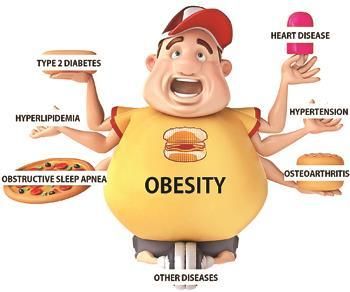
Obesity and Its Management
In this era of modernization there is a need to check our lifestyle that is very much influenced by the western world. Our faulty food habits, unhealthy and sedentary life style are the major cause of obesity which in turn produces many lifestyle disorders like hypertension, diabetes, cholesterol, cardiac complaints etc.
Ayurveda which is a 5000 years old ancient science has a holistic approach to life. In Ayurveda sthaulya (obesity) is regarded as medoroga (a disorder of meda dhatu-one among the seven dhatus) which can be corelated with fat tissue and fat metabolism.
“Karsyameva varam sthaulyath”. The famous quote from AshtangaHridaya means that being a lean person is better than being obese. Sthaulya (obesity) is one among the 8 “nindya rogas” (diseases) i.e. which has a difficult prognosis and which is difficult to treat.
In obesity there is a collection of imbalances between tridoshas (vata, pitta, karpa), Agni ( factor which cause digestion and metabolism) and srothas ( the minute channels in the body for the passage of doshas and malas) which will hamper the proper formation of dhatus.
Th accumulation of ama (toxins) in the srotas causes the imbalance of vata dosha and the restricted movement of vata dosha increases the agni, leading to an increased appetite. Thus the person tends to take more and more food making him obese.
Management of obesity- Even though Ayurveda categorize sthaulya or obesity under disease which is difficult to treat, It also emphasize on the quote “ Swasthasya swasthya rakshanam, athurasya vikara prasamanam;” which means Ayurveda stands for maintaining the health of a healthy person and curing the diseased through its holistic approach. Ayurveda explains about healthy way of living through daily routines we should follow in order to prevent all lifestyle disorders.
The three steps for the management of obesity are:
Nidana Parivarjanam– Evaluating the cause for the disease and stop continuing it.
Samana therapy– Pacifying treatment
Sodhana therapy– Purifying treatment.
Nidana Parivarjanam– Avoiding the cause:- Over eating, untimely eating, excess intake of fatty food, sweets, cold, heavy food etc ; day sleeping, exhilaration, lack of mental and physical activities, and genetic defect are said to be the causes for obesity according to Ayurveda.
Samana therapy– The mild form of treatment procedure by pacifying the doshas. Its done by langhana procedures (which produces lightness in the body). Langhana procedures are 4 types of evacuation (emesis, purgation, enema, oil instillation through nostril’s i.e nasyam ); tolerating thirst, exposure to wind and sun, intake of drugs/food which improves digestion, fasting and physical exercise .
Sodhana therapy– Purifications methods are done by Panchkarma procedures. Vamana (emesis), Virechana (purgation), vasti (medicated enema) are prime among the five. Vasti which has dry, hot, scrapping property drugs are specially indicated for obese people. Dry powder massage/ udvarthana is also a typical treatment for obesity. All the mentioned procedures should be taken under the supervision of an expert medical practitioner.
Dinacharya (daily routine) and personal hygiene explained in Ayurveda which helps in obesity are:
Wake up early in brahma muhurta (an auspicious time of waking up in the morning which is one and a half hour before sunrise). Wash face and hands, brush your teeth, scrape your tongue and eliminate urine and bowel. Its ideal to defecate in squatting position. It places the knees closer to the trunk and relaxes rectum completely. Sitting position places knees at 900 angle in abdomen blocking frees in the rectum. Vata predominant people are more prone to constipation.
Eliminating your bowel daily is very important while dealing with obesity management.
Abhyangam– Applying oil all over the body before bathing and gently massage. This will improve the circulation, skin tone, muscle tone, skin texture and burns superficial fat tissue. Applying oil regularly all over the body is an excellent anti-ageing procedure .
Taking bath in warm water is aphrodisiac, anti- ageing and brings glow to the body.
Vyayama (exercise) – Should be done regulatory which will provide lightness to the body, firmness,strength, anti-ageing, increase life span etc
Diet according to Ayurveda
According to charaka acharya, food should be taken in proper quantity. The quantity of food depends upon the power of digestion. Ideal time for food is twice daily, once in the evening and once in the morning. Food should not be taken within 3 hours of the previous meal. Quantity of food- if we divide our stomach into 4 parts; half should be filled with solid food, quarter should be filled with liquid food and remaining quarter portion should be kept free for movement of vayu.
Drinking of water–
Take 3 glass warm water in the morning on empty stomach which will initiate the bowel movements.
Cup of water should be taken before every meal who wishes to reduces their weight. By doing this, your stomach will be half full with water and this will reduce your hunger. You will automatically take lesser quantity of food.
The food which are light, hot in effect, dry which possess taste astringent, hot and bitter are good for reducing body weight. This will reduces the excess kapha dosha in the body.
Avoid refined sugar, salt, dairy, sweets, white bread, pastry, red meat. Cold food items, drinks, oils, refined flour, canned juices etc. Include fresh fruit juices, vegetables salads, beans, whole grains. Millets, honey, green tea.
Digestive herbs like black pepper, ginger, turmeric can be taken with teas. It burns up the fat. Eat only freshly cooked warm food. Do not take refrigerated and reheated food of previous day. Do not take incompatible diet, example ghee and honey in equal quantity, fish and milk together. Sour fruits and milk together etc.

